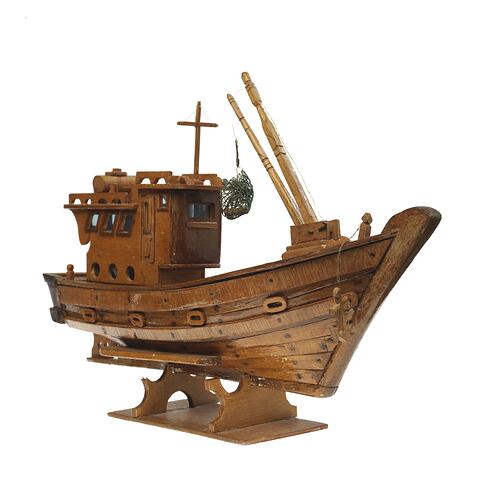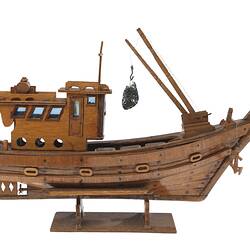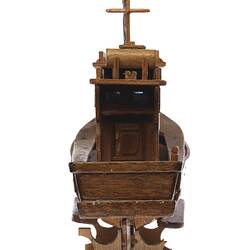Summary
Wooden model fishing boat and carry case made by Vietnamese refugee Do Van Lam while being processed in Sungei Besi A Transit Camp, Kuala Lumpur, Malaysia in 1981. He presented the boat on 16 October 1981 to Lachlan Kennedy, a member of the Australian Department of Immigration Indo-Chinese Refugee Taskforce, from January-September 1981. The boat was presented in a wooden case, inscribed with the artist's name and location details, wrapped in sheets of newspaper from The Sunday Mail, New Straits Times, October 1981.
These boat models were not uncommon and this one was a gift to Lachlan who brought it home with him to Australia (along with a second model boat) and he gave it to his sister as a memento. Refugees had art workshops in the camps, which catered to this wide spread interest by making handcrafts. Sungai Besi had a reputation for producing quality models of Vietnamese fishing boats of the kind used by refugees to escape Vietnam.
Manual activity was prolific in the camps, with people making items (often from recycled materials) needed by the camp residents. Some of the camps in northern Thailand had small 'gift shops' where immigration staff, visiting officials, or interview teams could purchase items. In these camps people plied their trades as best they could, utilising their expertise in such activities as gold and silver jewellery making, gemstone setting, wooden furniture making, hairdressing, dressmaking and tailoring, drawing and painting, and weaving (by Lao and Khmer refugees).
Physical Description
Wooden lacquered model fishing boat with a cabin containing a wheel, masts, a fishing net and fishing lines, a till and metal propellor at rear. The boat sits on a wooden detachable stand. Small tacks and glue used to build the model. Wooden case with lid with handle at top, inscribed. Five sheets of packing newspaper.
Significance
This important collection represents two sides of the asylum experience - the refugees and the government officials. These parallel and intersecting experiences have both personal and bureaucratic elements to them, linked by place, and world events, with craft and gifts of appreciation providing tangible points of connection and memory. The experiences of migration officials are frequently untold and unrepresented by material culture, as are material manifestations of refugee narratives. This collection enables the telling of both stories, with primacy given in this instance to the employee as custodian of the objects. The collection is also a symbol of a particular period in Australian migration history when support for refugee programs had both bipartisan and public support. Finally the theme of refugee, internee and detainee craft recurs across time and place and provides a tangible connection between very different human experiences, the trauma, economy and the tedium of which has been consistently alleviated through artistic practice.
More Information
-
Collecting Areas
-
Acquisition Information
Donation from Mr Lachlan Kennedy, 16 Mar 2015
-
Recipient
-
Maker
-
Inscriptions
Case: 'Family/DO. VAN. LAM/Boat No DN 1635/Sungei Besi A. Souvenir 16.10.81/Dear Mr KENNEDY/AUSTRALIAN'
-
Classification
Migration, Processing - immigration selection, Refugee camps
-
Category
-
Discipline
-
Type of item
-
Object Dimensions
425 mm (Length), 118 mm (Width), 288 mm (Height)
Height measurement of boat on stand. Height without stand: 246mm
-
Object Dimensions
490 mm (Width), 193 mm (Depth), 273 mm (Height)
Case only
-
Keywords
Vietnamese Immigration, Refugees, Crafts, Water Transport, Water Vessel, Boats, Model Boats, Models & Modelmaking, Art, Artistic Practices, Immigration, Immigrant Voyages, Immigration Selection, Vietnam War Refugees







